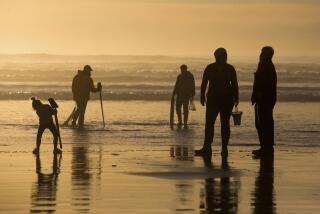Limits on Crabbing, Oyster Scarcity Add to Tensions in Chesapeake Bay : Maryland: Watermen blame officials and environmentalists for the decline of their way of life. Over-harvesting and disease reduced catch, leading to state restrictions.
- Share via
CAMBRIDGE, Md. — Chesapeake Bay watermen have always been a rough bunch.
In the 1800s, when oysters were so plentiful that ships sometimes ran aground on them, watermen from Maryland and Virginia routinely shot it out while raiding each other’s oyster beds.
Now, with the bay’s oyster industry devastated by disease and the state imposing new restrictions on crabbing, there’s tension on the waterfront--even if the watermen are no longer shooting at each other.
On remote Smith Island, a storage shack used by a conservation group that called for the tough restrictions on blue crabs was burned. A cormorant, a type of bird, was found dead in a fish tank at a building the group uses. A tourist boat was slathered in sticky oil.
The vandalism is widely suspected to be the work of watermen, many of whom see their way of life slipping away with smaller harvests of oysters and crabs on the Chesapeake Bay, the nation’s leading supplier of blue crabs.
“They don’t think you know anything because you haven’t been to college,” Byron Cameron, who has worked on the water for 20 years, said of the state environmental officials responsible for the crabbing restrictions. “We’d be better off if some of the people with college educations would stay out of it.”
The blue crab is the unofficial symbol of Maryland, appearing on T-shirts, coffee cups and other souvenirs. Feasts of blue crabs steamed in a fragrant, peppery seasoning are as much a summer tradition along the mid-Atlantic coast as baseball and the beach.
The bay’s crab business is worth $50 million to $75 million a year to watermen. Last year, 43.5 million pounds were taken. But this year’s harvest probably won’t exceed 40 million pounds.
Virginia, which shares the bay with Maryland, said last summer’s crab harvest there was the worst in 36 years.
Maryland officials said the crabbing restrictions--which include a shorter work day and a season 45 days shorter--are needed to protect the bay’s most valuable commercial resource. The state believes pollution and over-harvesting by watermen are to blame for the declining crab haul.
But some watermen in Maryland blame the state for the crab problem. The state stocked the bay with young rockfish, which feed on small crabs, to restore a rockfish population that they say would have been replenished naturally.
One waterman, who didn’t want to be identified, complained that watermen who use trot lines, or baited hooks, to catch crabs had more restrictions placed on them than those who use pots, or traps.
“But don’t you be putting my name in the paper. Talking to a reporter is dangerous. Next thing you know, my car will be spray-painted, or my house windows,” he said.
As for oysters, the diseases MSX (multinucleated sphere unknown) and Dermo nearly wiped out the Chesapeake Bay harvest two years ago, though the oyster industry on the bay was on the wane years before that. The bay now faces stiff competition from Louisiana, Texas and other East Coast regions.
Watermen working the Choptank River stopped harvesting oysters for a week to protest the $15-a-bushel price being offered by buyers on the river. That’s $7 less than a year earlier.
On Smith Island, fishing or fixing the boats of those who do is the only work around.
“Crabbing and oysters, that’s the only thing we can do on the island. Crabbing is one of our biggest money-making products today with the Dermo and MSX killing all the oysters,” said Dennis Bradshaw, a waterman himself who works for the Chesapeake Bay Foundation, whose shack was torched. “Take away that and watermen will be in bad shape with the oyster situation like it is.”
Bradshaw said a recent meeting between watermen and foundation officials helped smooth things over.
“The watermen went away with a lot better feeling toward the foundation after that meeting,” Bradshaw said. “That doesn’t mean both sides are going to agree with everything, but they will try to work with each other in the future.”
Still, watermen have not always been able to work things out among themselves.
Oystering was so profitable in the 1860s that 20 to 30 trainloads left daily for restaurants around the region. Maryland and Virginia watermen raided each other’s beds, often at night, and dredge boats often sneaked into rivers, where only hand tonging was legal.
The invading watermen were often met with gunfire, leading the Maryland General Assembly in 1868 to form the Oyster Navy to keep watermen from shooting at each other. The plan worked, but the watermen began shooting at the oyster police instead.
Larry Schweiger, head of the Chesapeake Bay Foundation’s environmental defense program, said waterman and his environmental group share common goals.
“I think we will have our differences, but ultimately, our bottom-line goal is the same,” Schweiger said. “We want an ample resource, and to get there we need to stop pollution and restore management of the fishery.”
More to Read
Sign up for Essential California
The most important California stories and recommendations in your inbox every morning.
You may occasionally receive promotional content from the Los Angeles Times.













